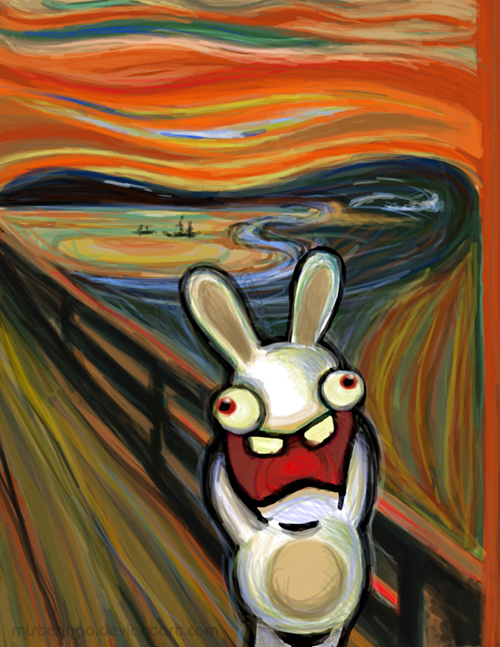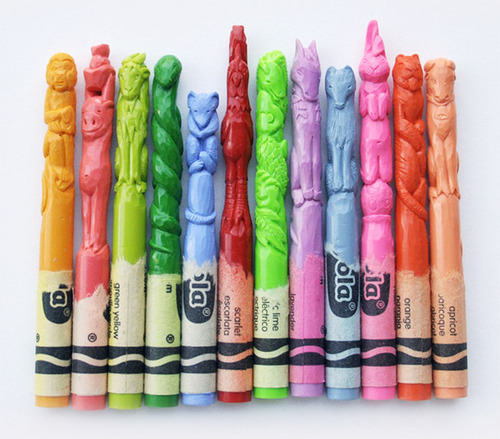Just about 2 weeks ago, my AEP teacher assigned us an essay writing homework on "Srikandi", by Lucia Hartini. I flipped through all my notes and did some research before I was able to complete this assignment. I HOPE I DID WELL :D
Q1a. Describe the use of space, colour and brushwork.
Lucia Hartini’s painting of Srikandi (1993) depicts a life-size figure with near perfect likeness to herself. This authoritative, challenging and strong figure takes up most of the painting’s foreground, making her the main focus of the painting. The female figure is said to be a strong and powerful female knight character of the Javanese shadow theatre, Srikandi, painted with her fists clenched and muscled hands akimbo, her head up with confidence and wide-open staring eyes, a challenging gesture against the spying eyes before her. The female figure is draped in a long flowing blue cloth, which flows to the painting’s background, causing the viewer’s eyes to move along with it.
The walls next to her zigzags into the distance, creating a good use of space and depth. The cracking walls represents her previous confusion and fear. This contrasts greatly with the firm stance of the female figure. The tertiary coloured walls also provide a strong contrast with the deep blue of the draping cloth, bringing out the vibrancy of the blue hues. This emphasizes on the cool colour, representing the cool attitude and clear mind of the female figure. Lucia Hartini also played around with the texture of the walls and the draping cloth, allowing them to bring out the other. The hard, defined and flat brown brick walls are painted next to the flowing and fluid blue drapery to bring out the contrast rather vividly. Also, the proportion of the figure as compared to the walls is unrealistic, proving that the composition is entirely out of the artist’s imagination. Also, it could symbolize that she is overpowering the fearful feeling she used to have against the society.
In the background, Lucia Hartini depicted a moon-lit sky, which is predominantly blue and yellow in colour. The yellow fills the top of the sky, while dark gloomy clouds surround the bottom. The shadows, produced from the contrast, clearly define the muscles and tan skin of the female figure. The moon rests lightly in the sky, depicting a peaceful and quiet mood in the background as compared to the authoritative and impactful feeling in the foreground. Again, this brings emphasis on the female figure and her superiority against the spying eyes.
All the forms are painted with smooth and well-blended brushstrokes. Each stroke is painted with extra care and every line is defined clearly, showing many details such as the folds of the drapery and the cracks of the brick walls. The shadows and highlights are also painted with care. This created a surrealistic style throughout the painting, even when the figures and forms are painted with great detail and rather realistically. The unnatural and imaginative composition adds to the surrealistic nature of the painting.
Q1b. Comment on the influences behind this work.
Lucia Hartini’s painting of Srikandi (1993) is largely influenced by her own personal experiences and beliefs. One of the strongest influences would be her struggles against the sexism and cultural beliefs in Indonesia. Lucia Hartini is largely affected by the socio-political problems in Indonesia, where the people expects a woman to just do household chores and have children, her status depending on that of her husband, father or male siblings. She is regarded as an obedient subject who is to subject herself patiently to male control and admonition. Also, living in a male dominated society, her social status as one of the few female artists causes people to look at her with a critical eye, deeming her artworks as low quality pieces. Moreover, Lucia Hartini makes a living fully from painting and struggles to make a living to support her family as a single mother. Therefore, she has developed the habit of painting at night after her children go to bed. This might have influenced her painting of the moon in many of her paintings.
Lucia Hartini spent her childhood living, walking around and playing in a natural, quiet and peaceful environment, which is different from the neighborhood she is living now with her children. This result in her longing for a free and peaceful environment, influencing her to depict her imaginings of outer space, planets, sea waves and biomorphic rocks in many of her paintings. She paints these rhythmically in fine lines, using this method as a form of meditation to release the stress she feels from the people around her. She transforms her moods from her daily life into a daydream experience and fantastic new world that is depicted in her paintings, as a form of therapy. Therefore, she paints with vivid colours and great detail, for example the vibrant blue drapery in the painting. This influenced her to paint in a surrealistic style, transporting herself to another world to escape from the Indonesian society.
However, Lucia Hartini strongly believes that sexism comes out of cultural ignorance and refuses to submit herself to the cultural pressure exerted by the society in Indonesia. She thinks that women should represent themselves as autonomous subjects having potential which is different but no less capable than that of their male counterparts. She tries to overcome her difficulties with dealing with the societal stress on her by making her figures to be spirited, bold and assertive in her recent paintings. She also includes symbols in her painting as a response to the society norm. For example, the disembodied eyes in the painting, Srikandi, represents the society’s expectations of her as a woman and their disapproval of her as an artist and the walls cracking represents her triumph over the society norm. She also depicts Srikandi, as seen from the title of the painting, a daring, strong and powerful female knight character of the Javanese shadow theatre. She could have personified herself as Srikandi to symbolize her breakthrough for her personal growth and overcoming her fears and defeat. She repels the critical eyes of the society, which had rendered many woman prisoners of tradition. This can be seen from the confident and strong figure in the paintings staring openly and defiantly at the scrutinizing eyes.
Lucia Hartini’s painting, Srikandi (1993), is strongly influenced by her personal breakthrough in life and the courage she had to overcome the critical opinions of the society she lives in.
So... Here is my essay on "Srikandi" C:




















